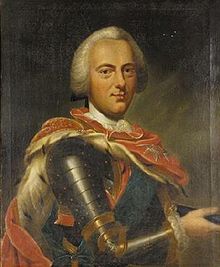Charles I, Duke of Brunswick-Wolfenbüttel
Charles I, Duke of Brunswick-Wolfenbüttel | |
|---|---|
 Charles I, Duke of Brunswick-Wolfenbüttel | |
| Born | 1 August 1713 Brunswick |
| Died | 26 March 1780 (aged 66) Brunswick |
| Noble family | House of Guelph |
| Spouse(s) | Princess Philippine Charlotte of Prussia |
| Issue | Charles William Ferdinand Sophie Caroline Mary Anna Amalia Frederick Augustus Elizabeth Christine Ulrike Augusta Dorothea Maximilian Jules Leopold |
| Father | Ferdinand Albert II, Duke of Brunswick-Lüneburg |
| Mother | Antoinette Amalie of Brunswick-Wolfenbüttel |
Charles (German: Karl; 1 August 1713, Braunschweig – 26 March 1780, Braunschweig), Duke of Brunswick-Lunenburg (Bevern line), was ruling as Prince of Wolfenbüttel from 1735 until his death.
Life


Charles was the eldest son of Ferdinand Albert II, Duke of Brunswick-Lüneburg. He fought under Prince Eugene of Savoy against the Ottoman Empire before inheriting the Principality of Wolfenbüttel from his father in 1735.
On the suggestion of his priest, Johann Friedrich Wilhelm Jerusalem, in 1745 he founded the Collegium Carolinum, an institute of higher education which is today known as the Technical University of Brunswick. He also hired Gotthold Ephraim Lessing as the librarian for the Bibliotheca Augusta, the ducal library. Lorenz Heisters of the University of Helmstedt named the botanical genus Brunsvigia in his honour, in recognition of his encouragement of botany and the study of B. orientalis.[1]
Charles attempted to promote the economic development of his state; for example, he founded the Fürstenberg Porcelain Company, and he installed mandatory fire insurance. However, he did not manage to keep the state finances in check. As a consequence, in 1773 his eldest son Charles William Ferdinand took over government.
Marriage and children
In 1733, Charles married Philippine Charlotte, daughter of King Frederick William I of Prussia. They had the following children that reached adulthood:
- Charles William Ferdinand (1735–1806)
- Sophie Caroline Mary (1737–1817), married Frederick, Margrave of Brandenburg-Bayreuth
- Anna Amalia (1739–1807), married Ernest Augustus II, Duke of Saxe-Weimar-Eisenach
- Frederick Augustus (1740–1805)
- Albert Henry (1742–1761), died childless
- William Adolf (1745–1770), died childless
- Elizabeth Christine Ulrike (1746–1840), married King Frederick William II of Prussia (divorced)
- Augusta Dorothea, Abbess of Gandersheim (1749–1803)
- Maximilian Jules Leopold (1752–1785), died childless
Charles also had a child out of wedlock, Christian Theodor von Pincier (1750–1824), the adopted son of Baron von Pincier of Sweden.
Ancestry
References
- ^ Snijman, Dee (April 2005). "Brunsvigia". www.plantzafrica.com. South African National Biodiversity Institute. Retrieved 14 April 2016.
The name Brunsvigia was first published in 1755 by Lorenz Heisters (1683-1758), a botanist and professor of medicine at the University of Helmstädt. It honours Karl, the Sovereign of Braunschweig, who promoted the study of plants, including the beautiful Cape species B. orientalis.
